
What’s
New in cocoaModem 2.0 v0.33, v0.34 and cocoaPTT update
Kok
Chen, W7AY [w7ay (at) arrl.net]
Last updated: June 27, 2007
Click here
for the previous (v0.32) What’s New page.
What has changed since v0.34?

The
current checkpoint of cocoaModem remains at v0.34.
A new cocoaPTT has been posted. In addition to being able
to select RTS or DTR, this version allows you the select
"Both" RTS and DTR. AE6TI had written to me that the
Rigblaster nomic will not unkey once cocoaPTT is launched.
I managed to find the schematics of the nomic and
discovered that the RTS and DTR signals in the nomic are
wire-ORed together to form the PTT keying signal. Selecting
"both" RTS and DTR in the latest cocoaPTT (see documentation) will make this
device work.
You may need to update the cocoaPTT preferences if you
decide to update the cocoaPTT application (if cocoaPTT is
working for you, you do not need this update).
What has changed in v0.34 ?
Fixed a bug that is caused by an
un-initialized log script pointer if a fresh copy of
cocoaModem (instead of an update) is installed.
What has changed in v0.33 ?
The user interface for all cocoaModem
interfaces which support two receivers has changed.
Interfaces that have a waterfall display now include a
noise reduction option for the display. The spectrum
analyzer tool in the Config panels now have spectrum
averaging and also noise floor compensation.
A new feature is added, and a bug was fixed in the PTT
interface. Command-T now also forces the main cocoaModem
window to become the key window.
You can now extend Morse to include unimplemented pro-signs
and European Morse characters. The output attenuator for
the CW interface has also been fixed. A latency popup menu
is added to the CW receiver.
The Feld Hell bandpass filter is narrowed to 230 Hz to
remove secondary keyclicks, and a FM Hell 105 bug is fixed.
The input attenuator for MFSK16 is fixed and a carriage
return from some program is now treated also as a newline
character.
The contest macro repeat function works again. cocoaModem
now sends a setup sequence to the microKEYER to switch the
audio routing in the keyer to use AFSK.
The CoreModem and CoreFilter frameworks have been updated.
cocoaPTT has been modified to
ignore characters in the data port. Download the updated
version from here.
The Audio Interface and PTT sections in the User's Manual
have been expanded and moved out of the User's Manual to
its own Interfacing section, with
subsections on Audio Interface and PTT.
Dual Receiver Behavior
The behavior for the interfaces with dual receivers (PSK31,
Dual RTTY, Wideband RTTY, CW) has changed.
Before cocoamodem 2.0 v0.33, the two receive sections
(tuning indicators, text view, controls, etc) have remained
fixed in cocoaModem's main window whether you transmit on
one or the other.
With cocoamodem 2.0 v0.33, the receive sections will swap
places so that the receiver section that is closer to the
bottom (i.e., closer to the transmit interface) will be the
interface whose tones you will be using to transmit with.
The PSK interface in cocoaModem allows you to copy two
different signals within a single common passband,
indicated by either a Green (xcvr 1) or a magenta (xcvr 2)
marker in the waterfall . The transmit select button
remains unchanged and lets you choose which of these two
tones to use as your own transmit carrier frequency.
A green indicator light (in the small control panel on the
right of the xcvr section) was used to indicate which xcvr
you choose to transmit on. Now, the indicator light is
either green or magenta to give a further interface clue as
to where you are transmitting through. The following shows
the color indicator if you choose to transmit with xcvr 2.
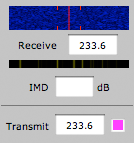
With the dual receiver RTTY and CW interfaces, cocoaModem
uses two passbands that can be connected to two independent
receivers. Each receiver comes with its own waterfall.
The way you select which receiver to use as the transmit
tones has not changed -- as before, you still need to
select the receiver that correspond VFO on the physical
transceiver you are transmitting through. However, like the
PSK interface change, the receiver sections (including the
waterfall) will exchange places, placing the receiver whose
passband you are transmitting through closer to the bottom
(i.e., closer to the transmit interface). During a "split"
operation, the DX should therefore appear on the upper
receiver and his QSX (where the pileup is) should appear in
the lower receiver.
Waterfall Noise Reduction
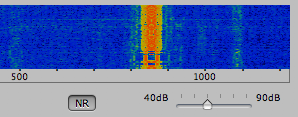
A noise reduction algorithm has been added to help clean up
the waterfall displays. The noise reduction does not impact
the demodulators but just the visual appearance of the
waterfall. Press the NR button below a waterfall to turn
noise reduction on and press it again to turn it off.
Spectrum Averaging
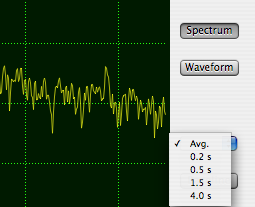
![]()
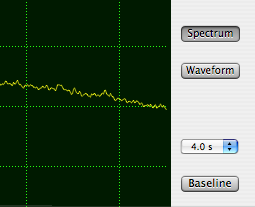
In the past, only the spectrum display of the Dual RTTY
interface had included spectrum averaging. That
functionality is now available on the spectrum displays in
the Config panels. There is now a popup menu that normally
reads Avg. Just as with the Dual RTTY interface, you can
now select 0.2, 0.5, 1.5 and 4 seconds of (exponential)
averaging for the spectra in the Config panels. This should
help improve the accuracy of estimating signal to noise
ratio of signals, and also for calibration of audio
filters.
The follow is an example of the noise bandwidth (sky noise
on 20m) of a pair of cascaded I.F. filters consisting of a
stock 500 Hz I.F. filter together with an INRAD 400 Hz
filter in an FT-1000MP, using 4 second of spectrum
averaging:
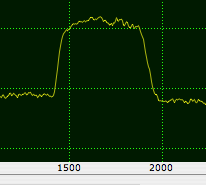
In addition, there is a Baseline button that tries
to maintain a constant noise baseline as the noise level
changes; this can be useful when comparing signal-to-noise
ratios from various antennas.
Each of the dotted horizontal lines remains separated by 20
dB.
PTT
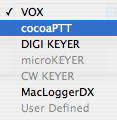
![]()
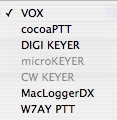
When a User Defined PTT is chosen in the AppleScript
Preference, the menu entry in the PTT menus used to become
un-grayed out and appear as "User Defined."
Now, when you select a folder that contains the user script
files, the PTT menu will show the name of the folder
instead of "User Defined". In the example shown above, I
had pointed the User Defined Scripts to a folder named
W7AY PTT. When you use AJ0O's application TS2K-L, which has scripts to control
the TS-2000's PTT using CAT, the menu item in
cocoaModem's PTT menus will now say TS2K-L.
See the PTT documentation in the Interfacing
section for more details.
There was a bug in the cocoaModem PTT Hub which caused
cocoaModem to abort when a previously selected User Defined
Script folder can no longer be found. cocoaModem now
continues to run even when it fails to load the script.
Key Window

When transmitting, the main window of cocoaModem has to be
made the key window, otherwise any text that
you type will not go into the transmit view.
In the past, if you had opened an aux window in the RTTY
interface and had selected the aux window as the key
window, the keyboard shortcut Command-T will turn on the
transmitter but the aux window will remain the keyboard
focus. Anything that you type will not be passed to the
transmit text view until you've clicked on the main window
to make the main window the key window.
Now, if you hit Command-T (or select the Transmit item in
the T/R menu), cocoaModem will automatically select the
main window to be the key window. Anything that you type
will go into the transmit text view.
CW
![]()
You can now associate arbitrary Morse sequences (European
characters, pro-signs, etc) to a keyboard key by adding
that information to a file called Morse.txt in the
Library/Applications Support/cocoaModem folder of your home
directory.
See the CW documentation for more details.
The output attenuator for the CW transmit config panel was
left unconnected; it should now work.
The automatic CW decoder has some pipelines built in to
take care of noisy or poorly keyed Morse characters. This
causes the characters to appear much later than they were
received. In v0.33, a Latency popup menu has been
added to skip some of the post processing.
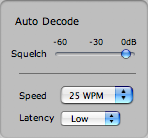
The menu can be selected to use low latency (least
post processing), medium and high latency
(most post processing). You might prefer to use low latency
for chasing DX and high latency for ragchews and printing
news bulletins, where accuracy is more important than
latency.
Hellschreiber
Feld Hell is now passed through a 230 Hz (+,- 115 Hz)
bandpass filter. The previous filter was letting though a
-20 dB keyclicks that are 110 Hz to 200 Hz away from the
center of the Feld Hell signal.
There was a bug that occurred when you switched to FM Hell
105 after transmitting in either Feld Hell or FM
Hell 245 modes. The switch used to cause the phase of the
modulating signal to be shifted by 90 degrees; the FM 105
text then appears at the receiving end as fuzzy characters.
MFSK16
The MFSK16 input attenuator slider should now work (if the
A/D converter is controllable).
On teletype machines, a Carriage Return should only point
the text to the beginning of the current line and not
advance the platen to the next line. Many programs violates
this convention, however -- some Windows programs send only
a Carriage Return as a signal for a newline. To accommodate
them, cocoaModem now maps both Carriage Return or Linefeed
as a newline indicator. If a Carriage Return and a Linefeed
are paired, cocoaModem will threat the pair a single
newline.
With LSB mode is selected, the carrier marker in the
waterfall used to jump in the wrong direction between first
clicking and after a signal has finished acquiring. That is
now fixed and the waterfall marker in both LSB and USB
should now jump to the zero tone of an MFSK16 signal after
it is acquired and locked.
Contest Interface
![]()
A previous cocoaModem checkpoint had a bug which
immediately terminated the transmission of a repeated macro
in the contest interface. That should now be fixed.
Frameworks
CoreModem and CoreFilter were changed to allow greater
flexibility with defining Matched Filters (specifically the
RTTY matched filters) .
cocoaPTT
![]()
cocoaPTT has been modified to open the serial port for
write-only. If the serial port input data line was
connected to physically active port, in addition to the RTS
or DTS control signals, the system input buffer would
eventually hang the port unless some other program is
actively reading the stream. Please reinstall cocoaPTT from
the download page if you are using it as
your PTT device.
micro KEYER Setup String
The microHAM micro KEYER has audio routing relays to
reroute the line and microphone inputs. The onboard EEPROM
determines the state of the audio routing when you first
turn the micro KEYER on. If your micro KEYER has been
defaulted to be used as a voice keyer, cocoaModem was not
able to transmit if you had wired the computer to use the
line input instead of the microphone input of the micro
KEYER.
cocoaModem now initializes the micro KEYER to accept the
line input for audio routing. This does not permanently set
the EEPROM state.
However, it also changes the other flag bits in the setup
string (the micro KEYER does not allow only specific bits
to be changed). If the initialization that cocoaModem uses
conflicts with other applications, you can redefine the
setup string using the micro KEYER setup string
field in the Connection tab of the Preferences panel.
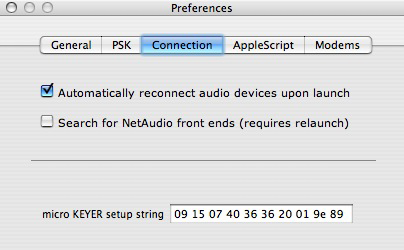
This does not affect the other microHAM models such as the
CW Keyer, the digi Keyer or the USB Interface II, none of
which supports audio routing.
(If you would like to change the power-up behavior of a
microHAM keyer, I have some AppleScripts that you can use
with the µH Router to change the EEPROM settings in the
keyers. Please email me if you would like a copy of the
scripts.)